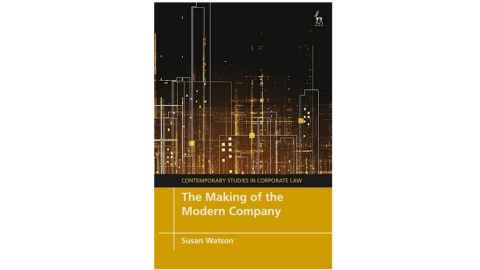New insights into the making of the modern company revealed
25 July 2022
Professor Susan Watson spent ten years looking to the past to explore the making of the modern company.

When did the modern company come about? What is the role of a company today? Can a company be good and do good?
A few years ago, talking about companies in any way other than that they're contractual, private, and have to act in the interests of current shareholders by maximising profits was considered fringe.
However, perspectives are changing, and in her new book, Professor Susan Watson expands on the debate by looking to the past to explore the key features of a modern company and the idea that companies can, and must, think beyond current shareholders.
Watson also eclipses long-held views on when the modern company began, with historical data indicating that it emerged much earlier than previously thought.
The author, who spent years researching the development of companies from the 17th century for her book The Making of the Modern Company, says people have typically understood that the modern company emerged in the 19th century based on an understanding that a company was contractually formed and therefore solely the private property of shareholders.
However, she argues that the modern company began in the 17th century when the English East India Company got a charter with permanent capital under Oliver Cromwell in 1657. Watson says it then had all the features of a modern company and for some time, operated in a way that demonstrated a long-term perspective, enhancing the opportunity to grow value, “because it was able to operate in the long term past the life spans of any individual shareholders".
"In part, because the English East India Company got permanent capital that was separated from shareholders first, for a period of time it outstripped every corporation in the world. The corporate form has the potential to generate enormous value over time."
Watson says understanding the operations of the behemoth trading company through a 21st-century lens helps to bring into focus what the modern company really is, its role and why it's such a successful vehicle for value creation.

Just like many modern, late-19th century companies of the gilded age, and the tech industry giants of today, the East English India Company was unstoppable unless or until the state intervened, says Watson, who draws on historical, comparative, interdisciplinary and theoretical perspectives, contemporary commentary and case law, as well as data from companies of the period to show how the advantages of separate legal entity and limited liability were gradually realised and exploited by corporations during these key periods.
Rather than being contractually created, Watson argues that the incorporation process creates a separate legal entity based on capital contributed by shareholders.
“That separation of the capital from shareholders creates an entity based on that capital that can operate in the world, acquiring and generating value. In its operations, it can consider the interests of people and planet as doing so is in the long-term interests of the entity. The interests of shareholders held as the capital of the entity are protected - as the value, including the reputation of the entity, grows, so does the value of shareholders' capital.”
Watson says management by a board subject to legal duties to the company as an entity based on shareholders' capital that can exist in perpetuity facilitates a long-term perspective by the board that can accommodate both shareholder and wider stakeholder interests.
"This understanding of the company is contrary to a prevailing perspective. Many people consider that companies are essentially contractual; that people get together and form a company contractually that they incorporate. These shareholders then employ directors as their agents who act on their behalf and operate the company. The struggle then is to think: what is the company's role beyond maximising profits for those current shareholders?”
So, says Watson, any of the newer developments around the fact that perhaps companies should think more about the long term and about their impact on the world are hard to reconcile with the fact that directors are supposed to be acting on behalf of the current shareholders as owners.
“That's the contractual understanding, but in my book, I argue that actually, you can't replicate the key features of the modern company through contract.
What incorporation does is create what the law accepts, or what we all accept is an artificial legal person. That artificial legal person can transact in the world like any other person."

The process of incorporation also legally separates the contributions of shareholders as capital into that artificial legal person, says Watson.
"So really, a modern company can only be created and acquire those two key features through incorporation - essentially, a modern company is a capital fund that is an artificial legal person. States make incorporation possible through statutes like the Companies Act 1993. In return, we can expect companies to have regard to their impact on people and planet. Given that so much value of modern companies is attached to reputation, it is often good business to do that, especially in the long term. The happy irony is that benefitting people and planet also benefits shareholders through the capital fund.
"So modern companies wouldn't exist if there weren't an Act that permitted that process of incorporation. By understanding this, you get away from the problem of saying, well, a company is based on the current shareholders, so how can directors look beyond their interests?"
Watson's initial premise for The Making of the Modern Company changed when she discovered historical records from the East India Trading Company.
"I first came up with the idea for the book about ten years ago, but at that time, I thought this was a 19th-century story. I was trying to show that companies were first contractually based on their shareholders in the middle of the 19th century but by the end of the 19th century were recognised as separate legal entities from their shareholders.
But then, while doing the research, I came across all this material about the English East India Company through the 17th century. It was always a corporation, but a corporation, that totally changed from being based on single voyages with proceeds split up at the end, to a corporation that had permanent capital with shareholders receiving a return on capital."

Lots of things seem to have started with the East India Company in the 17th century, says Watson, much earlier than she had ever realised.
"For example, the minority also forced the preparation of accounts that had to show a true and fair view, which is the modern way you talk about accounts. Those accounts had to be audited."
Watson says it was fascinating and, of course, time-consuming trawling through old English East India Company minute books online.
"They minuted everything everyone said. Regular shareholder meetings began with the East India Company and shareholder activism was a real feature. Their discussions were the same debates you see happening in companies these days around the rights of minority shareholders versus the majority shareholders who control the governing board.
“The minority investing shareholders in the East India Company usually got their way in the end because their investments were needed to fund voyages. At the beginning of the period, the majority used their control to look after their own interests. For example, many of the majority were merchants who sold commodities from voyages to themselves at a discount.”
Another trick was to make distributions through commodities like pepper, says Watson.
“That was fine if you were a merchant, as the majority shareholders were, but not so attractive if you were a small investor like a country squire, a sea captain, or a gentlewoman. It was a lot of pepper to get rid of.
“By the end of the period all that had stopped. The governors/directors were required to swear an oath that essentially they would act in the interests of all of the shareholders – remarkably similar to the modern directors' duty. Those interests were held in the company as the permanent capital.”
Learn more about The Making of the Modern Company published by Bloomsbury.
Media contact
Sophie Boladeras | Media adviser
M: 022 4600 388
E: sophie.boladeras@auckland.ac.nz